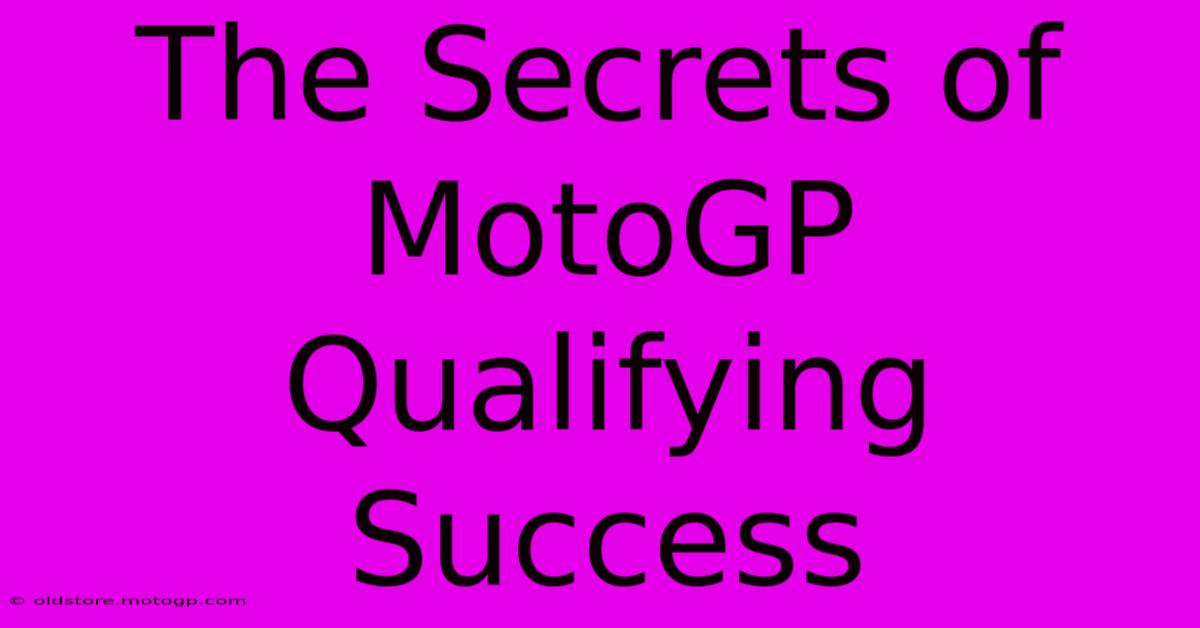The Secrets Of MotoGP Qualifying Success

Table of Contents
The Secrets of MotoGP Qualifying Success
MotoGP qualifying. The pressure is immense, the stakes are high, and the margins are razor-thin. A single tenth of a second can mean the difference between a front-row start and battling from the back of the grid. But what separates the qualifying kings from the also-rans? This article delves into the secrets behind MotoGP qualifying success, exploring the crucial elements that contribute to a rider's performance on this pivotal stage of a Grand Prix weekend.
Mastering the Machine: Bike Setup is Paramount
The foundation of any successful qualifying lap is a perfectly tuned motorcycle. Bike setup isn't just about finding the fastest single lap time; it's about finding the optimal balance between speed, stability, and rider confidence. This involves meticulous adjustments to:
- Suspension: Fine-tuning the suspension settings to optimize grip and stability through every corner is critical. The right balance allows the rider to push the limits without losing control.
- Aerodynamics: Modern MotoGP bikes generate significant downforce. Tweaking the aerodynamic components, such as the wings and fairings, can significantly impact cornering speed and stability on the straights.
- Electronics: Sophisticated electronics manage engine power delivery, traction control, and wheelie control. Optimizing these settings is crucial for maximizing acceleration and maintaining stability under braking.
Top riders and their teams spend countless hours refining these settings, often making minute adjustments based on track conditions and tire wear. This meticulous attention to detail translates directly into faster lap times.
Tire Management: A Delicate Balancing Act
Tire management is another crucial aspect of MotoGP qualifying. The tire's performance degrades throughout the session. Riders must balance pushing for the fastest possible lap time with preserving tire life for the race. This involves:
- Tire selection: Choosing the right tire compound based on track temperature and conditions is vital. A slightly softer compound might offer a quicker lap time, but it could also degrade rapidly.
- Consistent riding style: Maintaining a consistent riding style throughout the session helps to preserve tire life and prevents overheating. Aggressive riding early can lead to tire degradation, ruining the opportunity for a late-session improvement.
- Track awareness: Understanding how the track surface affects tire grip is essential. Certain parts of the track might be more abrasive or have lower grip, and adjusting riding style accordingly will improve performance.
The Rider's Role: Precision and Mental Fortitude
While bike setup and tire management are critical, the rider’s skill and mental game are equally important.
Precision and Technique:
- Smoothness: Smoothness is paramount. Jerky movements and abrupt changes in throttle input increase tire wear and reduce stability.
- Optimal braking points: Finding the optimal braking points and using the available grip efficiently is a sign of mastery.
- Line selection: Choosing the best racing line is essential. Even small deviations can significantly affect lap time.
Mental Fortitude:
- Pressure management: Qualifying sessions are intense. Top riders excel under pressure, maintaining focus and making calculated decisions.
- Self-belief: Self-confidence is crucial. Riders need to believe in their abilities to push their limits and achieve their best performance.
- Data analysis: Modern MotoGP teams rely heavily on data. Riders who can effectively analyze and interpret this data can make informed decisions during the session.
Strategic Approach: The Art of the Qualifying Lap
Finally, a strategic approach to the qualifying session is crucial. This involves:
- Track evolution: Understanding how track conditions change throughout the session is essential. The track often improves as more rubber is laid down.
- Tire strategy: A rider’s tire strategy impacts the whole session. Saving tires for a late push can lead to a breakthrough lap, but this strategy is risky.
- Slipstream: Using slipstream from other riders can help improve straight-line speed. This requires timing and skill to work effectively.
Mastering MotoGP qualifying is a complex combination of technical expertise, meticulous preparation, and unwavering mental strength. Understanding these secrets can greatly enhance the appreciation of the sport and the impressive feats of these incredible riders.

Thank you for visiting our website wich cover about The Secrets Of MotoGP Qualifying Success. We hope the information provided has been useful to you. Feel free to contact us if you have any questions or need further assistance. See you next time and dont miss to bookmark.
Featured Posts
-
Understanding Moto 2 Specs A Beginners Guide
Feb 20, 2025
-
Motorcycle Events Showcasing Famous Riders
Feb 20, 2025
-
Get Into Gear Exploring The Diverse World Of Motorbike Racing
Feb 20, 2025
-
Queen Circuit Adventures Unforgettable Experiences
Feb 20, 2025
-
Get The Most Out Of Cota The Detailed Austin F1 Map
Feb 20, 2025
